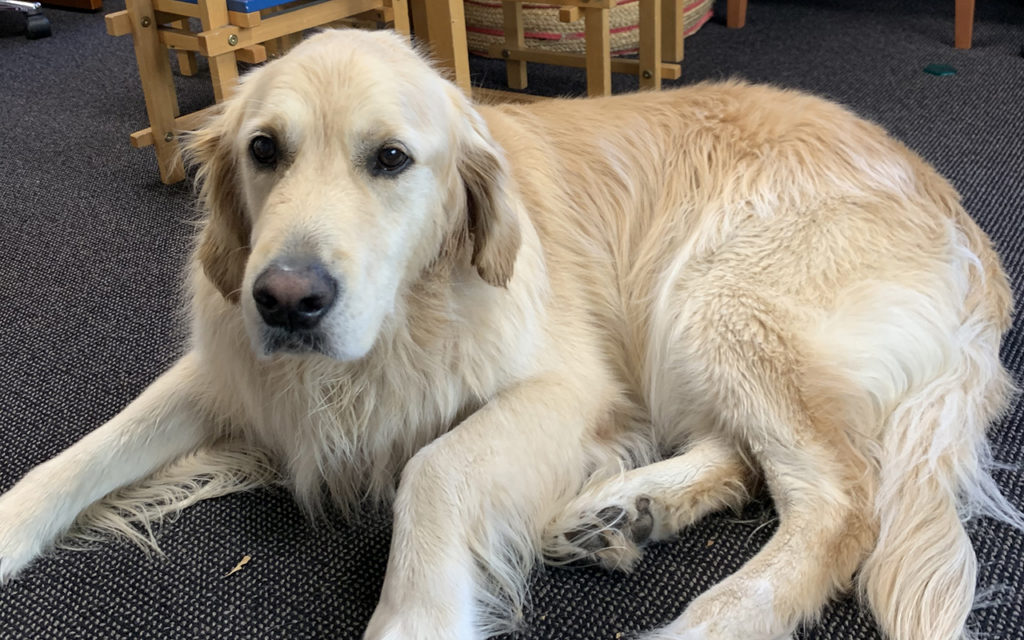HAVING raised our sons with the able assistance of the family Labrador, I was in no doubt about the importance and benefit to family life of the family dog.
As a child and family psychiatrist dealing with children and families suffering from extreme stress, I have always sought to provide a welcoming and nurturing environment in my office. Although I often thought of bringing our family Labrador into the workplace, her vulnerable temperament and lack of suitable training hindered this. Instead, her photo has sat in my office for over a decade. This has been a regular prompt in discussing healthy lifestyle issues with children and families. In one poignant interaction, a young woman stroked the photograph as she disclosed the trauma of her personal experience of child sexual abuse.
It is, of course, well recognised how mankind and dogs have evolved. It is for good reason that dogs have been regularly referred to as man’s best friend. The role of Guide Dogs is well established. The place of therapy dogs in hospitals and schools has been spoken of regularly (here, here, here, here and here). The benefits of having a family pet are well established, including the benefits of encouraging regular exercise. Walking the dog becomes a community event as one integrates with fellow dog owners and dog lovers.
Last year, I went on the hunt for a therapy dog to join me in my office. This was no easy process as I needed a dog with the right temperament, nature and training. The ideal of training a puppy was unfortunately unrealistic. I had almost given up the search before happening upon a dog share with a local dog owner. This beautifully trained 4-year-old golden retriever had the perfect temperament.

It is not possible to overstate the benefits that Otis has brought to my working life, our office environment and most particularly, to the children, family and adults whom I treat.
Improved quality of life
Otis attends daily at my office. He runs ahead from the lift, greeting our administrative staff and the families in the waiting room. He then welcomes them into the office, leading the way with a dramatic swish of his tail, purposeful trot and smiling face. For the occasional person who is uncomfortable with dogs or allergic to his fur, he will happily sit by my side. For most of the time, he settles by their feet, craving their attention. He is the beneficiary of constant patting and engagement.
Otis is a big dog, weighing in at over 30 kg. He is also a calm and welcoming presence, assisting in the challenging process of a child’s engagement with a middle-aged, bearded, bespectacled male psychiatrist as they explore their life experience, personal challenges and engage in a problem-solving approach in search of a better life.
A therapeutic tool
While I anticipated that the stroking of his soft fur would assist in self-soothing and his presence would assist in engagement, Otis has brought so much more. All involved – other office workers in the lift, administrative staff, patients and their families – smile when they interact with him. They smile a lot, enabling connections with positive life experiences, particularly involving family pets.
Otis is the perfect segue for an exploration of a wide range of therapeutic concepts. The importance of a healthy lifestyle, diet, sleep and exercise, can all be framed around the dog.
When training as a therapist, I was entranced by the My voice will go with you: the teaching tales of Milton H Erickson. Dr Erickson used stories to engage with his clients and effect lasting change. Otis has become the protagonist in my tales. Instead of using the gestalt therapy technique of talking to an empty chair to represent the absent other, the therapy dog is a readily accessible participant. Discussions around the interpersonal space and social skills training can be addressed with reference to him.
There are some vulnerable groups who have particularly responded to the presence of Otis. The first two children with phobia are now hassling their parents for their own dog. The in vivo exposure provides an opportunity to explore my “avoidance is the enemy” paradigm. As with equine therapy (here and here), children with autism have responded to the therapy dog when overwhelmed by the social engagement with myself as a psychiatrist. Otis has thus become their focus, enabling them to feel comfortable in the room. The therapy dog has become a bridge, enabling a therapeutic alliance with the therapist.
That said, this group is not alone in identifying Otis’ presence as their motivation to re-attend.
A sense of community
Otis has quickly become a talking point between staff and visitors on a daily basis in the lift, promoting a sense of community. This has extended to staff members from adjacent offices coming to visit him in our office, forging a warm bond in relationships that had previously been simply cordial.
When I spoke to colleagues about introducing a therapy dog into my practice, they would ask if he was there for the patients or for me. There is no doubt that the quality of my own experience in the workplace has improved as I work through the distressing experiences of the vulnerable children and families that I meet. My practice manager reports a similar experience for herself and in interactions in the waiting room. We all feel less stressed.
I think that the Victorian Government may be on to something with their proposed Dogs for Docs program!
Dr Antony Milch is a child, adolescent and family psychiatrist practising in Sydney. He has contributed to programs for adolescent mental health at The Black Dog Institute, and regularly lectures and presents at conferences. He is a contributing author to the Practitioner’s Guide to Psychoactive Drugs for Children and Adolescents.
The statements or opinions expressed in this article reflect the views of the authors and do not represent the official policy of the AMA, the MJA or InSight+ unless so stated.

 more_vert
more_vert
The reply @Saul Geffen has has unfortunately allowed his obvious bias against dogs to colour his report.
The author has unfortunately allowed his obvious bias towards dogs to colour his report. He has failed to report any of the negative studies
eg (Anestis, M. D., Anestis, J. C., Zawilinski, L. L., Hopkins, T. A., & Lilienfeld, S. O. (2014). Equine‐related treatments for mental disorders lack empirical support: A systematic review of empirical investigations. Journal of Clinical Psychology,70, (12), 1115-1132.)
Or here https://www.cochrane.org/CD013243/DEMENTIA_animal-assisted-therapy-people-dementia
Or here a review calling all the studies “low quality” https://www.ncbi.nlm.nih.gov/pubmed/24731910
Dogs kill 2-3 Australians a year and bite thousands more. Some causing horrific facial injuries in children. They are responsible for 4000 hospitalisations per year, horrifyingly those under 9 were most likely to be hospitalised (https://www.aihw.gov.au/getmedia/edcef144-69ba-4b06-ab63-cb3275ce920d/20366-dog-related-injuries.pdf.aspx?inline=true) and many thousand more doctor and ED presentations. They are the single most dangerous domestic pet.
Many people dislike them, some are phobic about them (sometimes with good reason) others are actually allergic to them. I don’t want them in my workplace, on the public transport I use or anywhere near my children. The evidence for their effectiveness in therapy has rarely been compared to a placebo and seems to be being pushed by those who have an overwhelming emotional fondness for them.
I look forward to the MJA via this e-magazine highlighting their dangers. After all the MJA did here (https://www.mja.com.au/journal/1997/167/3/public-health-impact-dog-attacks-major-australian-city) in a series of 6500 injuries in a single year in a single Australian city.
Lovely comments and great idea esp for our autistic patients- young and older.
Synapse’s headquarters in Brisbane has a dog friendly policy which my very small dog and I enjoyed immensely as did our co-workers. She is now 11 years old and I need to take her with me on a flight to Melbourne for Christmas however she is not a registered as an assistance dog although she is to me. I am coping with a paralysed hemidiaphragm following surgery and radiation. My best friend is too old to travel unaccompanied but would sit well behaved under my seat. How do I escape the rules of having her certified as a necessity for my stress?